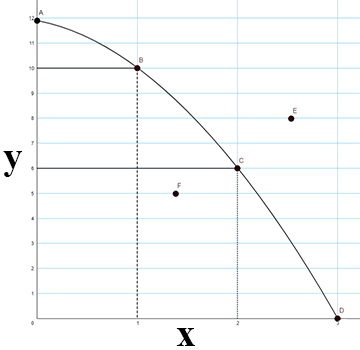Try It
PPF Practice
Use the PPF graph below to answer the questions

- Answer the following questions about Point A.
- How many "X" goods are produced at point A?
Answer: 0 "X" goods are produced at Point A
- How many "Y" goods are produced at point A?
Answer: 12 "Y" goods are produced at Point A
- How many "X" goods are produced at point A?
- Answer the following questions about Point B.
- How many "X" goods are produced at point B?
Answer: 1 "X" good is produced at Point B
- How many "Y" goods are produced at point B?
Answer: 10 "Y" goods are produced at Point B
- How many "X" goods are produced at point B?
- Answer the following questions about Point C.
- How many "X" goods are produced at point C?
Answer: 2 "X" goods are produced at Point C
- How many "Y" goods are produced at point C?
Answer: 6 "Y" goods are produced at Point C
- How many "X" goods are produced at point C?
- Answer the following questions about Point D.
- How many "X" goods are produced at point D
Answer: 3 "X" goods are produced at Point D
- How many "Y" goods are produced at point D?
Answer: 0 "Y" goods are produced at Point D
- How many "X" goods are produced at point D
- Now, mathematically determine the opportunity cost of choosing to use the factors of production differently. Assume this nation or business or individual was currently producing at point B, but has now decided to produce at point C because it wants 1 more "X" goods. What is the opportunity cost of this decision?
Answer: The opportunity cost of producing 1 more "X" good is 4 less of "Y" goods. 10 − 6 = 4.
- Now, mathematically determine the opportunity cost of choosing to use the factors of production differently. Assume this nation or business or individual was currently producing at point C, but has now decided to produce at point A because it wants 6 more "Y" goods. What is the opportunity cost of this decision?
Answer: The opportunity cost of producing 6 more "Y" goods is 2 less of "X" goods. 2 − 0 = 2.
You've completed this review!